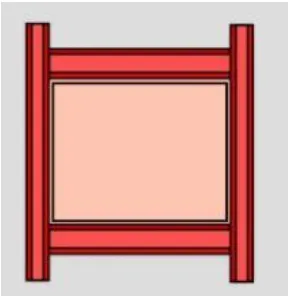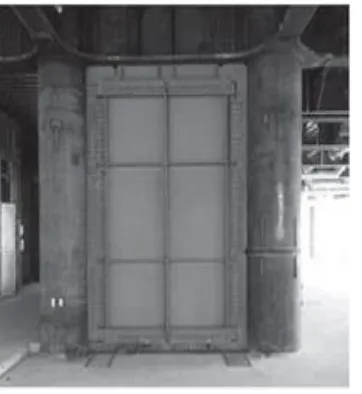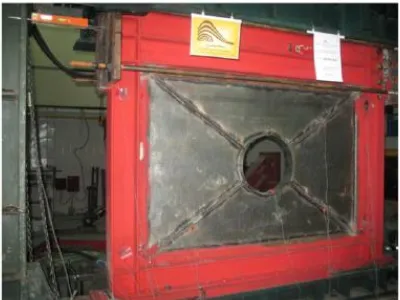Steel Plate Shear Wall - A Lateral Load Resisting System
Rijina T V
1, Sreemahadevan Pillai
21P.G Scholar, Dept. of Civil Engineering, NSS College of Engineering, Palakkad, Kerala, India
2Professor, Dept. of Civil Engineering, NSS College of Engineering, Palakkad, Kerala, India
---***---Abstract -
The evolution of tall buildings demand excellentlateral load resisting systems. In tall buildings, the wind loads and earthquake loads are very important and need to be considered in the design. Steel plate shear wall is a lateral load resisting system, having columns and beam as horizontal and vertical boundary element respectively, and a steel in-fill plates. Steel plate shear walls was emerged in early 1970’s, from there many researches were conducted on the same. In the beginning these were mainly used in Japan and United States so most of the early researches were concentrated on these parts. This paper is prepared to provide a summary on the past researches conducted on steel plate shear walls.
Key Words: Tall building, Lateral load-resisting system,
Steel Plate Shear Wall, in-fill plate, Horizontal boundary element, Vertical Boundary element
1.INTRODUCTION
Now in tall buildings, earthquake and wind load have been a great concern for designers, due to urban development and construction. In order to restrain the lateral forces, various systems having specific features are used. Proper selection of these lateral force resisting systems is very important and it depends on many factors like loading composition, structure behaviour, gravity load, economy, architectural design, etc. Structures must be designed in such a way that in addition to the gravity force, it must withstand the lateral forces also. For this specific elements like tensile bracing, moment resisting frames, concrete shear walls, are required. The steel shear wall system is one of such system having some unique advantages and features. It has excellent energy dissipation capacity, initial stiffness, load carrying capacity, etc. which is very important in high seismic areas.
Since 1970, steel shear wall systems was one of important choice among various alternatives. It was used in several modern and important buildings. In Japan, these were mainly used for new buildings. These were used for seismic rehabilitation of existing buildings in the United States. The steel plate shear wall system comprises panels, two columns border, and beams. The components of steel plate shear wall are marked in Fig. 1.1. The columns and beams in SPSW are called as vertical boundary elements (VBE) and horizontal
boundary elements (HBE) respectively. The vertical steel
[image:1.595.321.546.168.345.2]plate known as web plate, is connected to the columns and beams, which may be stiffened or unstiffened, based on the design philosophies. In stiffened the strength is more but the cost is high, so unstiffened is used, which utilize the post-buckling strength of plate.
Fig -1: Components of SPSW
Design recommendations for SPSW systems are now introduced in the AISC Seismic Provisions for Structural Steel Building (Steel Design Guide 20-Steel Plate Shear Walls). These provisions are developed based on many past experimental as well as numerical studies. The following section describes some of such important studies related to steel plate shear walls.
2. LITERATURE REVIEW
The first extensive research program on the behaviour of
steel plate shearwall panels was conducted by Takahashi et
al. (1973) in Japan. The study was on various configurations of stiffened shear panels, to determine their suitability for use as a lateral load-resisting system. The researches demonstrated that the stiffened panels dissipated significantly more energy than did the unstiffened panel, but the cost is high, although both types generally behaved in a stable and ductile manner.
[image:1.595.361.505.611.759.2]Fig - 3: Stiffened SPSW
In 1983, Thorbum et al. conducted studies on un-stiffened
steel plate shear walls and identified the post-buckling behavior. Then a model was developed based on the theory of pure diagonal tension, called strip model. In this model, the tension zone was modeled as a series of tensile only bars, oriented at same inclination as the tension stress in the web. This model helps to study the transfer of forces and resulting stress distribution in the web plate. Various parametric studies were also conducted to determine the influence of various factors like column stiffness, web thickness and panel dimensions, on the stiffness and strength characteristics of SPSW. The results show that the load carrying capacity of SPSW can be increased either by increasing the web thickness or by increasing the column stiffness.
Fig – 4
:
Strip model (Thorburn et al.1983)Robert et al. (1998) conducted a series of quasi-static cyclic
tests on un-stiffened steel plate shear panels to determine the hysteresis behavior of SPSW, and get a stable S-shaped hysteresis loop. A largr-scale, four-story, single bay steel plate shear wall specimen with unstiffened panels was tested using controlled cyclic loading to determine its
behavior under an idealized severe earthquake event. The test specimen proved to be very stiff, along with excellent
ductility and energy dissipation characteristics, and
exhibited stable behavior at very large deformations and for
manycycles of loading. A theoretical model was prepared for
predicting the hysteresis characteristics, and compared with the experimental. The experiments performed by providing openings shows that the strength and stiffness of panels decreased approximately linearly with increase in the size of
opening.
The effects of openings in SPSW were later studied by
Deylami et al. (2000). Introduction relatively big opening
reduce the shear and energy absorptioncapacity of the plate.
Morethan 50 different models were evaluated by non-linear
finite element analysis program. Moreover, the effect of
some important geometrical parameters such as plate
thickness, opening aspect ratio and opening percentage
were also studied. The study determined that the optimum aspect ratio for opening and shown that the optimum aspect ratio for opening depends mostly on the plate thickness rather than the percentage of the opening. They developed a more accurate method for computing the ultimate shear capacity of steel plate shear wall containing rectangular large opening.
Berman et al. (2004) determine the feasibility of light-gauge
SPSWfor use in the seismic retrofit of buildings. The study
was conducted on both flat and corrugated plates with epoxy
connection and welded connection tothe frame. The study
identifies the use of light-gauge steel plate shear walls as a viable seismic retrofit option for buildings. The incorporation of light-gauge steel provides substantial ductility and stiffness. From the experimental results, they concluded that corrugated profile infills offers good buckling strength but other advantages are limited.
Sabouri-Ghomi et al. (2005) presented Plate Frame
Interaction Model (PFI)of the Ductile Steel Plate Wall (DSPW). This model describes the interaction of various components and also the system’s overall hysteretic
characteristics. Vian et al. (2009) conducted an experimental
investigation of specially detailed ductile perforated steel plate shear walls. The special perforated panel SPSW
specimen with multiple regularly spaced holes exhibited
ductile behavior during testingand is a viable alternative to
a solid panel SPSW, to allow utilityaccess through the panel
without the need for stiffeners aroundthe perforations. The
tested specimens also had low yield strength steel infill
panels.
Choi et al. (2009) performed an experimental study to investigate the structural capacity of steel plate walls with various infill plate designs. Five three-story steel plate shear walls were tested. The parameters for this test were the
connection method between the boundary frame and the
[image:2.595.59.262.498.675.2]with infill plates connected only to thebeams exhibited an
excellent deformation capacity equivalentto that of the solid
wall with fully connected infill plates but load-carrying capacity and energy dissipation capacity decreased. The
coupled wall that was stiffened only with the end platesat
the wall opening also exhibited a good deformation capacity, equivalent to the deformation capacity of the solid wall.
Modification of strip model was done by Shishkin et al.
(2009) to an accurate representation of yielding and eventual deterioration of the wall.
Kurata et al. (2012) proposed a new configuration for
SPSWs, wherea plate with surrounding boundary elements
is installed at the middleof the bay, separate from existing
columns. The system incorporates stiffening of vertical
boundary elements by tension-rods to ensurestable energy
dissipation through the yielding of the thin steel platewhile
[image:3.595.49.268.306.410.2]limiting the dimension of the boundary elements.
Fig - 5: Mid-span SPSW (Kurataet al. 2012)
Alavi et al. (2013) presented a special combination of
diagonal stiffeners with a central perforation. The seismic
behavior of thenew system is experimentally investigated
and compared to the solid infill plate models. Test results show that the ductility ratio of the specially perforated
specimen is about 14% greater than the un-stiffened
specimen. The cyclic tests showed that the specimens have
had stable hysteretic loops and behaved as appropriate
energy dissipative systems.
Fig - 6: Special perforated diagonally stiffened specimen
(Alaviet al. 2013)
Farzampour et al (2015) compared the performance of
corrugated steel plate and simple steel plate shear walls,
with and without openings. Parameters studied are plate
thickness, angle of corrugation, opening size, and opening
placement. Behaviors of interest for comparison are initial stiffness, ultimate strength, energy absorption, force-displacement relationship. From the study, it was found that initial lateral stiffness, energy absorption and ductility,
increases by trapezoidal corrugatedsteel shearwalls butit
reduces ultimate strength. The energy absorption capacity is
approximately 25% higher for corrugated SPSWthan the
corresponding SPSW. This indicates the suitability of
corrugated SPSWwith an opening under cyclic loadings in
regard to different size ofthe openings.
Guoet al. (2015) studied performance dependency on the connections flexibility of the joints and suggested to use semi-rigid connections on the boundary frame with the SPSW system in engineering.
Zirakianet al. (2015) assessed the structuralbehavior as
well as plate-frame interaction (PFI) characteristics of un-stiffened low yield point SPSW. Low-yield stress steel plate shear wall systems improves the buckling stability, energy absorption capacity, and serviceability, in which material
yielding of infill plates may occur either before or afteror
even at the same time as geometrical buckling.
Steel plate shear walls consist of a rigidly connected girder
and two columns to form amoment resisting frame with a
steel plate infill. The moment resistingframe coupled with
the steel plate shear wall increases both redundancy and
ductile behavior of the system. A detailed finite element
analysis has been conducted by Farzampouret al. (2015), on
135 simple (unstiffened) steel plate shear walls and 405
corrugated steelplate shear walls (CSSW) with and without
openings. The result shows that ultimate shear strength of
SPSW is higher than that ofCSSW with a negligible margin.
The initial stiffness and ductility of corrugated shear walls
without anopening are generally higher than those of
un-stiffened shear walls, especially in lower thicknesses. The
energy absorption capacity is approximately 25% higher for
CSSWthan the corresponding SSW.
Bahrebar el al. (2016) conducted numerical study on SPSWs
with trapezoidally-corrugated and centrally-perforated infill plate, to investigate the cyclic behavior and energy absorption capacity. Introduction and increasing of size of
the web opening reduced the contribution of the infillplate
to the overall performance of the systemand to increase the
overallsystem demand on the boundary frame members.
Corrugated steel to significantly increase the strength of the
cold-formed steel shear walls but the ductility of the wall
was not suitable for seismic applications. One possible
solution toimprove the ductilityinvolves creating openings
in the corrugated sheet. Yuet al. (2016) investigated
light-gauged cold-formed steel shear wall using corrugated steel
[image:3.595.62.262.566.716.2]circularholes in corrugated sheathing changed the failure mode and improved the ductility of the tested shear walls.
Geet al. (2017) developed buckling-restrained SPSW and conducted shake-table test to study the seismic performance. The results showed that the seismic behavior was adequate
for survival inlarge seismic excitations.
To prevent brittle failure of beam-column connection, the
beam section is weakened with different methods. The
methods included the reduction of the beam section with
circular and elliptical webopenings, vertical slots in the web
and also the reduction of the beam flange. The nonlinear
finite element analysis performed by Asla et al. (2017)
shown that the model with slots in the beam web has the
best performance in terms of ductility,energy absorption,
stiffness and shear strength than the other proposed models.
Nassernia et al. (2017) examined the theoretical and
experimental aspects of specific types of tensile-braced
mid-span steel plate shear walls and the effects of circular
opening on the system. The mid-span implemented to avoid the need for strengthening the surrounding primary columns. The existence of openings in the system leads to higher ductility, but reduced the stiffness, energy absorption capacity and lateral loading capacity of the system.
3. CONCLUSIONS
Even though SPSW systems have been emerged since 1970s, their usage was limited, as the primary lateral force resisting system in buildings for more than three decades, due to the many reason. But, now their good performance in major earthquakes and experiments, and their recent inclusion in codes and standards indicates that SPSW has a good future.
By reviewing the above papers, it is clear that this system can be used for high rise building as a lateral force resisting system. Lots of valuable research works have been performed on SPSW worldwide to evaluate the static and dynamic behavior of SPSW for the past three decades, and many innovations like use of corrugated in-fills, low-yield point steel plate, mid-span SPSW, reduced boundary element, etc were made to improve its performance. Still we can expect many future developments in this system, so the SPSW as a “emerging lateral-load resisting system”.
REFERENCES
[1] Takahashi, Y, Takemoto, Y., Takeda, T., and Takagi, M.,
1973, “Experimental Study on Thin Steel Shear Walls and Particular Bracings under Alternative Horizontal
Load.” Prelim. Rep., IABSE Symp. On Resistance and
Ultimate Deformability of Structures Acted on by Well-defined Repeated Loads, Lisbon, Portugal, pp. 185-191.
[2] Thorburn, L.J., Kulak, G.L., and Montgomery, C.J., 1983,
“Analysis of Steel Plate Shear Walls.” Structural
Engineering Report No. 107, Department of Civil Engineering, University of Alberta, Edmonton, Canada.
[3] Robert G. Driver, Geoffrey L. Kulak, D. J. Laurie Kennedy,
and Alaa E. Elwi, “Cyclic Test Of Four-Story Steel Plate Shear Wall”, Journal Of Structural Engineering, February 1998. 24: 112-120.
[4] Robert G. Driver; Geoffrey L. Kulak, Alaa E. Elwi, And D. J.
Laurie Kennedy (1998), “FE And Simplified Models Of Steel Plate Shear Wall”.
[5] Ardeshir Deylami And Hossein Daftari, “Non-Linear
Behavior Of Steel Plate Shear Wall With Large Rectangular Opening”, 12WCEE 2000, 1-7.
[6] Jeffrey W. Berman And Michel Bruneau, “Plastic Design
And Testing Of Light-Gauge Steel Plate Shear Walls” , 13th World Conference on Earthquake Engineering Vancouver, B. C., Canada, August 1-6, 2004, Paper No. 3323
[7] Saeid Sabouri-Ghomi, Carlos E. Ventura, and Mehdi H. K.
Kharrazi,” Shear Analysis and Design of Ductile Steel Plate Walls”, Journal Of Structural Engineering, ASCE june 2005, 878-889.
[8] Darren Vian, Michel Bruneau, K. C. Tsai and Y.C. Lin,
“Special Perforated Steel Plate Shear Walls with Reduced Beam Section Anchor Beams. I: Experimental Investigation”, Journal Of Structural Engineering, ASCE March 2009, 211-220
[9] In-Rak Choi and Hong-Gun Park, “Steel Plate Shear Walls
with Various Infill Plate Designs”, Journal Of Structural Engineering, ASCE, July 2009, 785-796.
[10] Jonah J. Shishkin, Robert G. Driver, and Gilbert Y.
Grondin, “Analysis of Steel Plate Shear Walls Using the Modified Strip Model”, Journal Of Structural Engineering, ASCE, November 2009, 1357-1366.
[11] M. Kurata, R.T. Leon, R. DesRoches, M.Nakashima,
“Steel plate shear wall with tension-bracing for seismic rehabilitation of steel frames”, Elsevier, Journal of Constructional Steel Research 71 (2012) 92-103.UN
[12] Erfan Alavi , Fariborz Nateghi, “Experimental
study on diagonally stiffened steel plate shear walls with central perforation”, Journal of Constructional Steel Research 89 (2013) 9-20.
[13] Alireza Farzampour, Jeffrey A. Laman, Massod Mofid
, “Behavior prediction of corrugated steel plate shear walls with openings”, Journal of Constructional Steel Research 114 (2015) 259-268.
[14] Hong-Chao Guo, Ji-PingHao, Yun-HeLiu, “Behavior of
considering joint properties”, Elsevier Thin-Walled Structures (2015) 53-62.
[15] Alireza Farzampour, Jeffrey A. Laman, Massod
Mofid, “Behavior prediction of corrugated steel plate shear walls with openings”, Elsevier, Journal of Constructional Steel Research 114 (2015) 258-268.
[16] Tadeh Zirakian ,Jian Zhang, “Structural performance
of unstiffened low yield point steel plate shear walls”, Elsevier, Journal of Constructional Steel Research 112 (2015) 40-53.
[17] Milad Bahrebar, Mohammad Zaman Kabir, Tadeh
Zirakian, Mohammad Hajsadeghi, James B.P. Lim, “Structural performance assessment of trapezoidally-corrugated and centrally-perforated steel plate shear walls”, Elsevier, Journal of Constructional Steel Research 122 (2016) 584-594.
[18] Cheng Yu, and Guowang Yu, “Experimental
Investigation of Cold-Formed Steel Framed Shear Wall Using Corrugated Steel Sheathing with Circular Holes”, Journal Of Structural Engineering, ASCE, 2016, 142(12): 04016126-1-9.
[19] Masoud Hoseinzadeh Asla, Mahna Safarkhani,
“Seismic behavior of steel plate shear wall with reduced
boundary beam section”, Elsevier, Thin-Walled
Structures 116 (2017) 169-179.
[20] Minglan Ge, Jiping Hao, Jinguang Yu, Puzhen Yan,
Shaocheng Xu, “Shaking table test of buckling-restrained steel plate shear walls”, Elsevier, Journal of Constructional Steel Research 137 (2017) 254-261.
[21] Sina Nassernia, Hossein Showkati, “Experimental
study of opening effects on mid-span steel plate shear walls”, Elsevier, Journal of Constructional Steel Research 137 (2017) 8-18.
[22] Rafael Sabelli and Michel Bruneau, “Design Guide
20-Steel Plate Shear Walls”, American Institute Of Steel Construction, 2015.
[23] Jonah J. Shishkin, Robert G. Driver, and Gilbert Y.
Grondin, “Analysis of Steel Plate Shear Walls Using the Modified Strip Model”, Journal Of Structural Engineering, ASCE, November 2009, 1357-1366.
[24] Adam S. Lubell, Helmut G. L. Prion, Carlos E.
Ventura, and Mahmoud Rezai, “Unstiffened Steel Plate Shear Wall Performance Under Cyclic Loading”, ASCE, Journal Of Structural Engineering, April 2000 453-460.
[25] Gajendra Kumar Verma and Savita Maru, "Some


